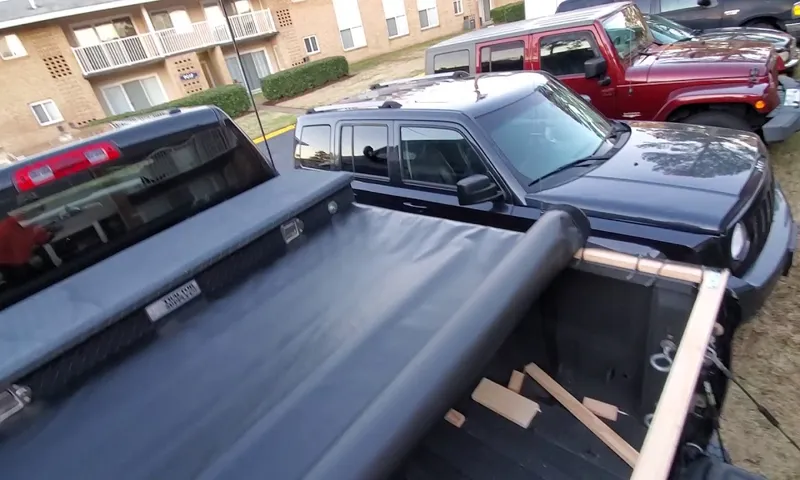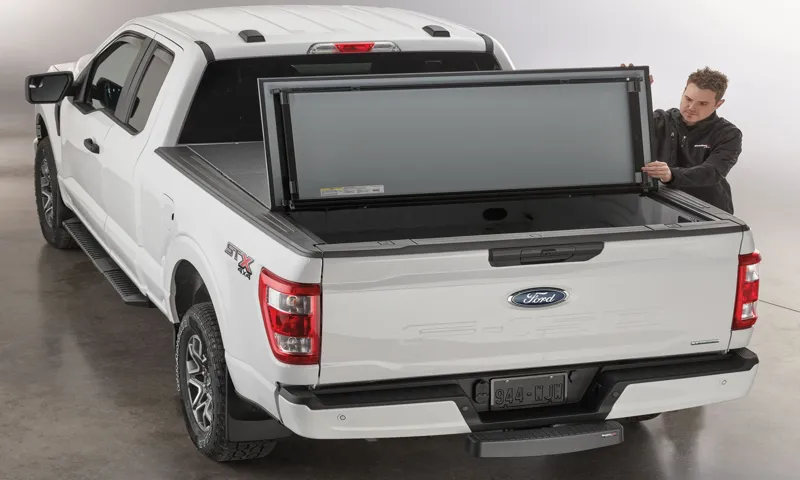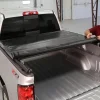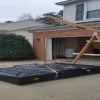If you’re a truck owner or soon to be, you’ve probably heard the term “tonneau cover” thrown around. But what exactly is a tonneau cover? Well, imagine this – you’re driving down the highway with your truck, and you want to protect the items in your truck bed from the elements or potential theft. Enter the tonneau cover, a versatile accessory designed to keep your truck bed safe and secure.
Think of the tonneau cover as a protective shield for your truck bed. It’s like the plastic wrap you use to cover your leftovers, but on a much larger and more durable scale. With a tonneau cover, you can prevent rain, snow, dirt, and even prying eyes from getting to your cargo.
It adds an extra layer of security, without sacrificing accessibility to your truck bed. But that’s not all – a tonneau cover also enhances the overall look of your truck. It gives it a sleek and finished appearance, as if your truck just rolled off the showroom floor.
Plus, it can improve your fuel efficiency by reducing drag and wind resistance. There are different types of tonneau covers available in the market, ranging from soft roll-up covers to hard folding ones. Each offers its own unique features and benefits, so you can choose the one that best suits your needs and preferences.
So, whether you’re a truck enthusiast or someone who simply wants to protect their cargo, a tonneau cover is definitely worth considering. It’s a practical and stylish accessory that can make a world of difference in your trucking experience. So why wait? Get yourself a tonneau cover and enjoy the convenience and peace of mind it brings.
Table of Contents
Materials and Tools Needed
If you’re looking to make a tonneau cover for your truck, you’ll need a few materials and tools to get started. First and foremost, you’ll need a strong and durable fabric. Look for a material that is weatherproof and resistant to tearing and UV rays.
You’ll also need a measuring tape to accurately measure your truck bed and determine the size of your tonneau cover. Additionally, you’ll need a heavy-duty sewing machine to sew the fabric together and create the cover. Other tools you may need include a ruler, pins, thread, and scissors.
It’s also a good idea to have some Velcro or straps on hand to secure the tonneau cover to your truck bed. With these materials and tools, you’ll be well-equipped to create your own tonneau cover and protect your truck bed from the elements.
Section One: Choosing the Right Materials
When it comes to starting a new project, choosing the right materials and tools is essential. You want to make sure you have everything you need to get the job done effectively and efficiently. The first step is to determine what materials you will need for your specific project.
This could include anything from wood or metal to fabric or paint. Consider the size and scope of your project, as well as your personal preferences. Once you have a list of the materials you will need, it’s time to gather the tools.
This could be anything from a hammer and nails to a sewing machine or a paintbrush. Again, consider the specific requirements of your project and make sure you have the necessary tools on hand. Choosing the right materials and tools is key to successfully completing your project and achieving the desired results.

Section Two: Gathering the Necessary Tools
Materials and Tools Needed for Building a Birdhouse. To build a birdhouse, you will need a few essential materials and tools. First and foremost, you’ll need some sturdy wood or plywood to construct the main body of the birdhouse.
Cedar or pine are excellent choices because they are durable and resistant to rot. Next, you’ll need a saw to cut the wood to the desired dimensions. A hand saw or a circular saw would work well for this task.
Another essential tool you’ll need is a drill. You’ll use the drill to create holes in the wood for the entrance and ventilation. A drill with a variety of drill bits will work best, as you’ll need different sizes of holes for different bird species.
You’ll also need some screws or nails to assemble the birdhouse. Depending on your preference, you can use either. Just make sure they are long and sturdy enough to hold the birdhouse together securely.
Additionally, you’ll need a hammer or a screwdriver to drive the screws or nails into the wood. To decorate and protect the birdhouse, you’ll need some exterior-grade paint or stain. This will not only make your birdhouse look attractive but also help protect it from the elements.
Bright, non-toxic paint colors can also attract birds to your birdhouse. Lastly, you’ll need some rope or wire to hang the birdhouse. You can use a strong rope or flexible wire to secure the birdhouse to a tree branch or post.
Step-by-Step Guide: Making a Tonneau Cover
Have you ever considered making your own tonneau cover for your truck bed? It may seem like a daunting task, but with a step-by-step guide, it can actually be quite manageable. So, grab your tools and get ready to embark on a DIY project that will not only save you money but also give you a sense of accomplishment. First things first, gather all the necessary materials.
You will need a high-quality fabric, such as vinyl or canvas, that can withstand the elements. Additionally, you’ll need a measuring tape, scissors, an awl, and heavy-duty adhesive. Once you have everything ready, measure the dimensions of your truck bed.
Start by measuring the length from the front of the bed to the tailgate, and then measure the width from one side to the other. Add a few inches to each measurement to allow for a proper fit. Next, cut the fabric to the appropriate size using your measurements as a guide.
Make sure to cut it in a rectangular shape with rounded corners to match the shape of the truck bed. Now that you have the fabric cut, it’s time to install it on your truck bed. Lay the fabric over the bed and position it so that it covers the entire area.
Use the adhesive to secure the fabric to the truck bed, starting from the front and moving towards the back. Make sure to smooth out any wrinkles or air bubbles as you go. To add extra security, you can also use an awl to create holes along the edges of the fabric and attach it to the truck bed using screws or bolts.
Once the fabric is securely attached, trim any excess material and test the tonneau cover by opening and closing the tailgate. Congratulations, you’ve successfully made your own tonneau cover! Now you can enjoy the benefits of a covered truck bed without breaking the bank. So, why not give it a try and show off your DIY skills?
Section One: Measuring and Cutting the Cover
Tonneau cover, measuring, cutting, step-by-step guide Are you looking to make your own tonneau cover? Well, you’re in luck because we have a step-by-step guide to help you through the process. The first step in making a tonneau cover is measuring and cutting the material for the cover itself. This is a crucial step that will determine how well the cover fits your truck bed and keeps your cargo secure.
So grab your measuring tape and let’s get started! Start by measuring the length and width of your truck bed. Make sure to account for any curves or angles that may affect the shape of the cover. Once you have these measurements, it’s time to transfer them onto your chosen material.
This could be vinyl, canvas, or any other heavy-duty fabric that is suitable for outdoor use. Using a sharp pair of scissors or a utility knife, carefully cut along the lines you’ve marked. Take your time and make sure to follow the measurements closely.
Remember, it’s better to cut slightly larger and trim down later if needed. Once you have the main piece of your cover cut out, you may need to make additional cuts for any openings in your truck bed. This could be for things like the tailgate, bed rails, or tie-down hooks.
Again, take your time and make precise cuts to ensure a proper fit. Now that your cover is cut, it’s time to attach any necessary hardware. This could include things like snaps, Velcro, or zippers.
Follow the manufacturer’s instructions for attaching these hardware pieces, making sure they are securely fastened. Congratulations! You’ve now completed the first step in making your own tonneau cover. By measuring and cutting the cover properly, you’re well on your way to creating a customized and functional cover for your truck bed.
Section Two: Sewing the Cover
Sewing the cover for your tonneau truck bed can seem like a daunting task, but with a step-by-step guide, it can be a fun and rewarding project. First, you’ll want to gather all the materials you’ll need, including fabric, thread, and a sewing machine. Measure and cut the fabric to the appropriate size for your truck bed, leaving extra room for seams.
Next, you’ll want to sew the edges of the fabric to prevent fraying. This can be done by folding the edge over and sewing a straight stitch along the edge. Once the edges are secure, you can start sewing the main body of the cover.
Start by sewing the front and back panels together, using a zigzag stitch for added strength. Finally, add any additional features, such as reinforced seams or a fastening mechanism, and make sure to test the cover on your truck bed to ensure a proper fit. With a little patience and practice, you’ll have a custom tonneau cover that not only looks great but also protects your truck bed.
So, grab your sewing machine and get started on creating the perfect cover for your truck.
Section Three: Attaching Fasteners
tonneau cover, attaching fasteners, step-by-step guide
Optional Modifications and Enhancements
So, you’ve got yourself a tonneau cover for your truck, but you’re looking to make some optional modifications and enhancements to take it to the next level? Well, you’ve come to the right place! There are several ways you can customize your tonneau cover to not only make it more functional but also give it a unique look. One popular modification is adding a bed rug or liner to the truck bed. This will provide a bit of cushioning and protection for your cargo, as well as make it easier to clean.
Another option is installing LED lights underneath the tonneau cover. This will not only illuminate your truck bed at night but also add a cool, stylish touch. If you’re in need of some extra storage space, you can also consider adding a storage box or rack system to your tonneau cover.
This will allow you to securely store items on top of the cover, freeing up space in the truck bed. Finally, if you’re looking to add some flair to your tonneau cover, you can opt for custom decals or graphics. This will give your truck a personal touch and make it stand out from the crowd.
By making these optional modifications and enhancements, you can customize your tonneau cover to suit your needs and make a statement with your truck.
Section One: Adding Reinforcements
optional modifications and enhancements. If you’re looking to reinforce your existing structure, there are a few optional modifications and enhancements you can consider. One option is to add steel or carbon fiber reinforcements to key areas of your building.
These reinforcements can provide additional strength and support, helping to prevent the structure from collapsing under increased loads or extreme weather conditions. Another option is to install an earthquake-resistant system, such as base isolation or energy dissipation devices. These systems are designed to absorb and dissipate the energy generated during an earthquake, reducing the impact on the building and improving its overall stability.
Additionally, you may want to consider adding additional fire protection measures, such as fire-resistant coatings or sprinkler systems. These enhancements can help to minimize the damage caused by a fire and provide additional time for occupants to safely evacuate the building. By incorporating these optional modifications and enhancements, you can further ensure the structural integrity and safety of your building.
Section Two: Installing Support Bars
Installing support bars in your home is an optional modification that can provide added safety and convenience. These bars are typically installed in bathrooms and other areas where extra support is needed, such as near a toilet or in a shower. They can be particularly helpful for individuals with mobility issues or balance problems.
Support bars come in a variety of styles and sizes, so you can find the option that best suits your needs and matches your existing decor. They are typically made of durable materials like stainless steel or brass, ensuring that they will last for years to come. By installing support bars, you can create a safer and more accessible environment in your home, providing peace of mind for you and your loved ones.
Tips and Tricks for a Successful Tonneau Cover
So you’ve decided to invest in a tonneau cover for your truck, but now you’re wondering how to make it successful? Well, you’ve come to the right place! A tonneau cover not only adds style to your truck, but it also provides protection for your cargo and improves fuel efficiency. To make your tonneau cover successful, there are a few tips and tricks to keep in mind. Firstly, it’s important to choose the right tonneau cover for your truck.
There are different types of tonneau covers available, including roll-up, folding, and hardtop covers. Consider your needs and preferences – do you want easy access to your cargo or maximum security? Once you’ve determined the type of cover you want, make sure to measure your truck bed accurately to ensure a proper fit. Next, installation is key.
Follow the manufacturer’s instructions carefully and make sure to secure the tonneau cover properly. This will ensure that it stays in place while driving and effectively protects your cargo from the weather and theft. Additionally, regular maintenance is crucial to keep your tonneau cover looking and functioning its best.
Clean it regularly with mild soap and water and avoid using harsh chemicals that could damage the cover. Another tip for a successful tonneau cover is to consider additional accessories. There are countless options available, including bed liners, cargo management systems, and weather sealing kits.
These accessories can enhance the functionality and efficiency of your tonneau cover, making it even more convenient for your truck. Lastly, don’t overlook the importance of proper usage. Make sure to secure your tonneau cover when not in use to prevent any damage from wind or other external factors.
Additionally, if you need to transport oversized items that exceed the height of your truck bed, consider removing the tonneau cover temporarily. In conclusion, by following these tips and tricks, you can ensure a successful tonneau cover for your truck. Choose the right type, install it properly, and maintain it regularly.
Section One: Taking Accurate Measurements
tonneau cover, measurements, tips and tricks, accurate measurements Paragraph: So you’ve decided to invest in a tonneau cover for your truck. Great choice! A tonneau cover not only adds a stylish and sleek look to your vehicle, but it also provides protection for the bed against the elements and keeps your cargo secure. But before you rush into buying a tonneau cover, there’s one important step you shouldn’t skip – taking accurate measurements.
This is crucial because a perfectly fitting tonneau cover will not only enhance the overall appearance of your truck but also ensure maximum functionality. To get started, gather a measuring tape and a notebook. Begin by measuring the length, width, and height of your truck bed.
It’s essential to measure from the inside edges to account for any protrusions or curves. Don’t forget to note down these measurements as you’ll need them when shopping for a tonneau cover. Remember, precise measurements are the key to finding the perfect fit.
Section Two: Sewing Techniques
One of the most important aspects to consider when making a tonneau cover is the sewing techniques you use. These techniques can determine the overall durability and effectiveness of the cover. Here are some tips and tricks to help you create a successful tonneau cover.
Firstly, it’s important to choose the right fabric for your tonneau cover. You’ll want to make sure it’s durable and weather-resistant, as it will be exposed to various elements. Look for fabrics that are specifically designed for outdoor use, such as polyester or canvas.
These fabrics are often treated to be water-resistant and UV-resistant, ensuring that your tonneau cover will stand up to the elements. Next, make sure you have the right tools for the job. A heavy-duty sewing machine is essential for sewing through multiple layers of fabric and creating strong seams.
You’ll also need the appropriate needles and thread. Use a heavy-duty thread that is specifically designed for outdoor use to ensure that it won’t degrade over time. When sewing your tonneau cover, pay attention to the seams.
Reinforce them by sewing multiple rows of stitching or using a zig-zag stitch. This will provide extra strength and prevent the seams from unraveling. You can also use binding tape or bias tape to finish the edges of the fabric for added durability.
Another tip is to use reinforcement patches in areas that will be under stress, such as the corners or attachment points. These patches can be made from the same fabric as the tonneau cover and sewn onto the cover for added strength. Reinforcement patches can help prevent tears or damage in areas that are most likely to experience wear and tear.
Section Three: Maintaining and Cleaning the Cover
Maintaining and cleaning your tonneau cover is essential to ensure its longevity and keep it looking its best. One tip for maintaining your cover is to regularly inspect it for any signs of damage or wear. This includes checking for any tears or cracks in the material, as well as inspecting the hinges and latches for any signs of rust or corrosion.
By catching and addressing these issues early on, you can prevent them from getting worse and potentially causing further damage. In terms of cleaning, it is recommended to use a mild soap and water solution to gently clean the cover. Avoid using harsh chemicals or abrasive scrubbers, as these can damage the cover’s finish.
Additionally, make sure to thoroughly rinse off any soap residue to prevent it from drying and leaving streaks on the cover. Overall, taking the time to regularly maintain and clean your tonneau cover will not only keep it functioning properly but also help to prolong its lifespan and enhance its overall appearance.
Conclusion
And there you have it, a tonneau cover fit for a king (or, you know, your truck). With just a few simple steps, some creativity, and a little bit of DIY magic, you can save yourself a ton of money, add some style to your vehicle, and have a tonneau cover that’s uniquely yours. Now, you may be wondering why we’ve called it a tonneau cover.
Well, it’s actually a French term that literally means “barrel” or “cask” cover. Back in the day, when people transported goods in barrels, they would use these covers to protect their precious cargo from the elements. So, you’re not just making a tonneau cover for your truck, you’re connecting with a rich history of resourcefulness and ingenuity.
But let’s not forget the real reason you’re here – to show off your DIY skills and make your truck look like a million bucks (or enough to buy a tonneau cover, at least). So gather your materials, channel your inner handyman (or handywoman), and let the world see just how clever and capable you truly are. Remember, making your own tonneau cover is more than just a practical solution, it’s an opportunity to showcase your individuality and creativity.
So, be bold, be daring, and most importantly, be proud of your DIY masterpiece. Who knows, maybe one day you’ll be starting your own tonneau cover empire. Until then, happy crafting!”
FAQs
What is a tonneau cover?
A tonneau cover is a protective covering for the bed of a truck or pickup. It helps to keep the cargo secure and protected from weather conditions.
Why should I use a tonneau cover?
Using a tonneau cover has several benefits. It helps to improve fuel efficiency by reducing air drag, protects the cargo from elements, prevents theft of valuable items, and enhances the overall appearance of the truck.
How to choose the right tonneau cover for my truck?
When choosing a tonneau cover, consider factors such as the type of truck bed, your budget, the level of security and protection you require, ease of installation and use, and the desired style or appearance.
Are tonneau covers waterproof?
Most tonneau covers are designed to be weather-resistant and can withstand light rain or snow. However, only a few models are truly waterproof. It is recommended to check the product specifications or look for covers specifically labeled as waterproof if you require maximum protection against water.
Can I install a tonneau cover by myself?
Yes, most tonneau covers come with detailed installation instructions and can be installed by the average truck owner with basic tools. However, if you are unsure or prefer professional installation, it is recommended to consult a local truck accessory shop.
How to maintain and clean a tonneau cover?
To maintain a tonneau cover, regularly clean it using mild soap and water, avoiding harsh chemicals that can damage the cover’s material. Additionally, inspect the cover for any tears or damages and promptly repair them to ensure continued protection.
Can I still access my truck bed with a tonneau cover installed?
Yes, many tonneau covers are designed to provide easy access to the truck bed. These covers may feature folding, rolling, or retractable mechanisms that allow you to quickly and easily open the cover when needed.



